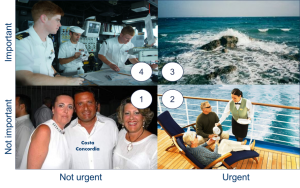Towards an effective S&OP with Stephen Covey

Since the publication of Covey’s “The Seven Habits of Highly Effective People” in 1989, more than 15 million copies have passed the counter, making it one of the best selling management books ever. The seven habits that Covey describes are brilliant in their simplicity. No more than common sense, you could argue, but why the massive interest and appreciation? Let us examine the power by applying one of the habits to S&OP: “put first things first.”
Covey classifies possible actions based on importance and urgency and advises on how to act per quadrant.
1. Quadrant 1: “avoid”. An effective manager does not spend time and energy on these topics and even eliminates them from the list. Easier said than done, but very liberating.
2. Quadrant 2: “Minimize / delegate”. Spending the day in quadrant two is perhaps the biggest pitfall of many managers. Too often, we let urgent operational matters dictate our agendas.
3. Quadrant 3: “stress”. Important and urgent and therefore top priority. No choice and that is exactly why an effective manager should avoid spending too much time here. No choice by definition means reactive leadership; focusing on solving problems for which the foundations were laid somewhere in the past. Managers that are frequently forced into quadrant 3 may feel indispensable, but do not add enough value. By reacting to whatever comes your way you may win some battles, but not the war.
4. Managers who succeed to structurally spend a significant portion of their time in quadrant 4 can really make a contribution to their companies. Anticipating rather than reacting, sufficiently far ahead to enable effective decision taking and implementation.
Obvious but not so simple in practice, as we will demonstrate now by applying these principles to S&OP. Let us not waste our time on quadrant one, but focus on the other three:
A typical operational S&OP process with an effective planning horizon of 2-3 months should be categorized in quadrant 2. The process has to be executed, but due its limited planning horizon it is by definition reactive and can not make a significant impact. In fact, it is execution rather than planning. To be delegated to the operational team members therefore, according to Covey.
Delegation is not an option for urgent and important decisions; they require prioritising and rapid action. The problem is that this category distracts us from adding real value. Effective managers should be taking optimal decisions about opportunities and threats that are not urgent yet, based on well-prepared data and scenarios. Focus on urgent and important decisions is a major reason that many tactical S&OP processes do not sufficiently contribute to the bottom line; they are hijacked by these urgent problems, leaving insufficient time for real anticipation. Experience shows that this is almost unavoidable as long as we try to combine taking decision in the different quadrants in one process.
So what is the solution? The figure presented shows a concept that has proven its potential in a number of implementations. By realising that there are different planning horizons, explicitly building them into the process design and allocating different frequencies, participants and preparations to them, the probability that quadrant four gets swamped by urgent matters is reduced significantly. The planning horizons and frequencies in the figure are indicative, but based on actual implementations. This results in an operational process with weekly alignment between Sales and Supply Chain, conducted by the operational team. In addition, there is a tactical monthly S&OP process, which looks ahead 6-9 months. Bigger decisions by more senior participants, but often still too late for really important decisions as major launches, investments and the like. Once per quarter, this process is therefore augmented by a strategic/tactical step, consisting of a thorough market analysis and outlook for the next 12-18 months plus the expected consequences for all relevant business functions. Depending on the size and complexity of the business, this is done by the same team or by senior management.
Conclusion: by recognizing the different Covey quadrants and making them explicit, S&OP effectiveness can increase significantly. A more complex process maybe at first sight, but with a much greater impact on the bottom line!




